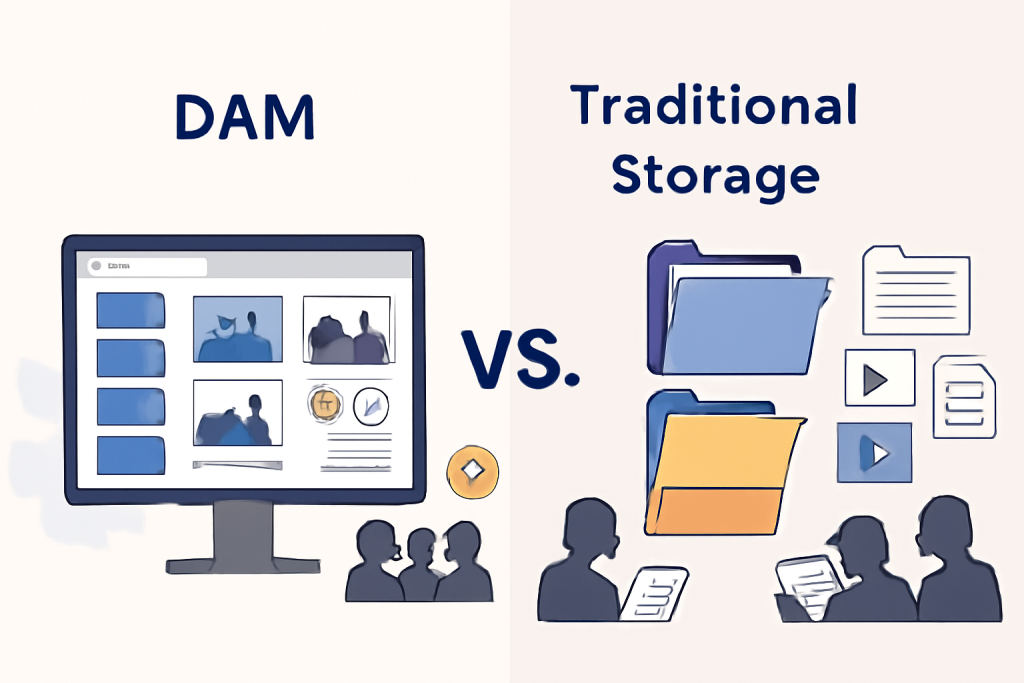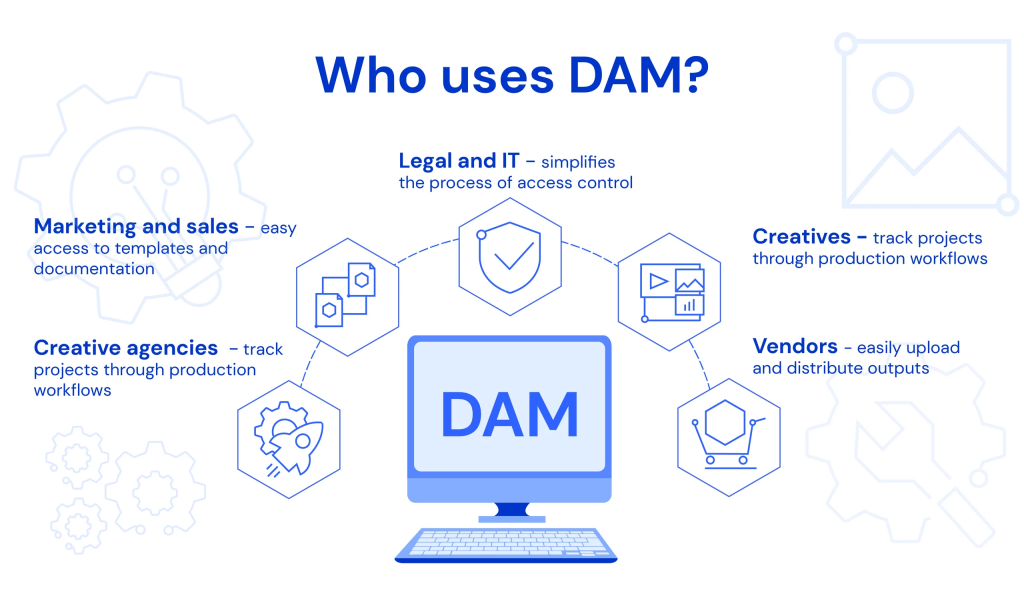As businesses scale, managing an ever-growing volume of digital assets becomes a significant challenge. Digital assets, including images, videos, audio files, documents, and graphics, play a pivotal role in marketing, branding, and overall business operations. With the increasing reliance on digital content, it’s essential to have a system that not only stores these assets but also makes them accessible, secure, and easy to manage.

In this blog, we will compare Digital Asset Management (DAM) systems with traditional storage solutions to help you understand which is better for managing your growing assets. Specifically, we will explore how Wizbrand, a leading DAM solution, stands out as a robust choice for businesses looking to scale their asset management and enhance team productivity.
What is Traditional Storage?
Traditional storage methods refer to systems like physical drives (hard drives, USBs), network-attached storage (NAS), or cloud storage services such as Google Drive, Dropbox, or OneDrive. These are common methods used by businesses for storing digital content, especially in small to medium-sized enterprises (SMEs). While these storage solutions are often affordable and easy to set up, they come with limitations when managing large amounts of digital content.
What is Digital Asset Management (DAM)?

Digital Asset Management (DAM) software, on the other hand, is specifically designed to store, organize, retrieve, and manage digital assets like images, videos, documents, and other multimedia. Unlike traditional storage methods, DAM systems are built to optimize workflows, ensure easy access, and provide advanced features such as metadata tagging, version control, and content collaboration.
Wizbrand, for example, provides a comprehensive DAM solution that helps businesses manage their digital assets efficiently, ensuring streamlined workflows and easy team collaboration. With features such as centralized storage, automated tagging, and secure sharing options, Wizbrand takes digital asset management to the next level.
Key Differences Between DAM and Traditional Storage
1. Organization and Accessibility
Traditional storage often leaves assets scattered across multiple folders or devices, making it difficult to maintain a clear, consistent structure. The absence of advanced search and tagging features can make retrieving specific files time-consuming and inefficient, especially as the volume of assets grows.
In contrast, DAM software like Wizbrand provides a centralized platform where all assets are stored, categorized, and tagged with metadata. This tagging system ensures that content can be easily searched, filtered, and accessed by team members. With Wizbrand, users can quickly find the right file, whether by keyword, category, or project, eliminating the frustrations of traditional storage solutions.
2. Version Control and Collaboration
In traditional storage systems, managing different versions of a file can become cumbersome. Team members may unknowingly work with outdated versions, leading to confusion and errors. There is also a lack of real-time collaboration tools, meaning that sharing files and collaborating on updates can be slow and error-prone.
DAM systems, including Wizbrand, offer built-in version control that tracks every iteration of an asset, ensuring that the latest version is always available to the team. Additionally, DAM software facilitates real-time collaboration, enabling multiple team members to access, edit, and share files simultaneously, regardless of their location. This functionality speeds up workflows and enhances team productivity, especially for teams working remotely or across multiple departments.
3. Search and Retrieval
Traditional storage systems often require manual organization of files into folders, and locating specific files can be challenging, particularly as the volume of assets grows. Without robust search functionalities, businesses may waste significant time looking for the right file, leading to delays in project timelines.
With DAM systems, the ability to search for assets based on metadata, keywords, tags, or categories makes retrieval much faster and more efficient. Wizbrand enhances this by allowing users to filter and search for digital content using advanced features. This saves valuable time and helps teams stay on track with their projects.
4. Security and Access Control
While traditional storage solutions offer basic security measures, such as password protection, they lack the advanced security and permission controls needed for businesses dealing with sensitive or proprietary content. Additionally, traditional systems may not provide sufficient safeguards against data breaches or unauthorized access.
DAM software, on the other hand, offers more robust security features. Wizbrand, for instance, provides customizable access controls, allowing businesses to restrict who can view, edit, or share specific assets. This is essential for businesses that handle sensitive data or need to ensure that only authorized personnel can access certain content. Additionally, many DAM systems offer backup and disaster recovery features, ensuring that digital assets are safe from accidental loss or corruption.
5. Scalability and Flexibility
As businesses grow, their digital asset management needs change. Traditional storage systems may struggle to keep up with this growth, requiring additional investments in physical storage or cloud space. This can lead to inefficiencies and increased costs.
DAM systems like Wizbrand are designed to scale with your business. As your digital assets grow, you can easily expand your DAM system to accommodate more content without compromising performance. Wizbrand also integrates seamlessly with other business tools, such as SEO Management Software, enabling businesses to streamline their workflows and better manage their growing digital content.
Why Choose DAM Software Like Wizbrand Over Traditional Storage?

While traditional storage solutions may work well for small businesses with limited digital assets, they become increasingly inefficient as businesses scale and digital content increases. DAM software, on the other hand, provides a scalable, organized, and secure way to manage digital assets. Here are a few reasons why you should consider a DAM solution like Wizbrand:
- Streamlined Workflows: With features like advanced search, version control, and real-time collaboration, Wizbrand helps teams work more efficiently and reduces the time spent searching for and organizing assets.
- Improved Collaboration: Wizbrand allows team members to collaborate seamlessly, ensuring that everyone works with the most up-to-date assets and reduces the risk of errors and miscommunication.
- Scalable and Flexible: As your business grows, Wizbrand scales with your needs, allowing you to manage an increasing number of digital assets with ease.
- Better Security: With customizable access controls and advanced security features, Wizbrand ensures that your digital assets are protected and only accessible to authorized team members.
Conclusion
When it comes to managing digital assets, businesses must decide whether to rely on traditional storage solutions or invest in a dedicated DAM system. While traditional storage may work for smaller teams with fewer assets, it lacks the features and scalability needed for growing businesses. Wizbrand, a leading DAM solution, provides a comprehensive system for managing and organizing digital assets, offering enhanced collaboration, better security, and streamlined workflows.
To ensure your business is prepared for future growth and success, explore Wizbrand today and discover how our DAM platform can help you manage your digital assets more efficiently and effectively.